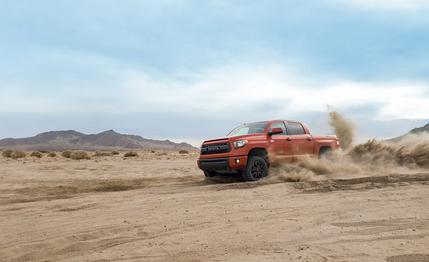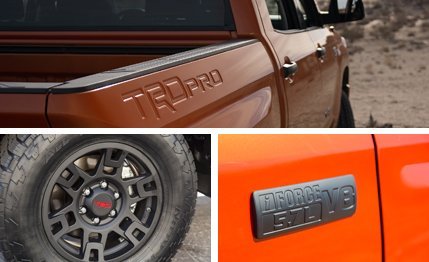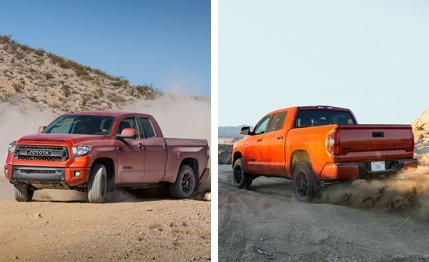 First Drive Review
First Drive Review
The successful F-150 SVT Raptor was a big gamble on Ford’s part, yet it captured the hearts and minds—and wallets—of dirt-slinging enthusiasts. Keen to place its own wager in the burgeoning segment of factory off-road performance, Toyota and its Toyota Racing Development (TRD) group invited us to Las Vegas to see whether or not the new 2015 Tundra TRD Pro can play at the Raptor’s game.
A Big Softie
On paper and in person, it’s easy to dismiss this Tundra as a badge-and-tape special with fancy shocks. Despite a two-inch suspension lift up front, it lacks the lane-clogging presence of the Ford and even wears the same all-terrain P275/65R-18 Michelins as on the standard truck. But the TRD Pro’s unique wheels, “TOYOTA” lettering on the special grille, and “TRD PRO” stamped into the bed sides suggest something’s afoot, which the bellow from the 381-hp, 5.7-liter V-8’s TRD dual exhaust confirms.

Toyota has leveraged its 30-plus years of off-road-racing experience to build a truly formidable 4x4 package without compromising the core drivability of the standard Tundra, which was updated for 2014. Our highway drive from the Vegas strip into the surrounding desert was uneventful, the big truck’s softer suspension setup and long wheelbase lending a smooth ride and only slightly dulling the truck’s responses. The so-called double-cab and stretched CrewMax body styles available with the TRD Pro Tundra gear guarantee abundant interior space, and the off-road stuff doesn’t limit payload or towing capacities as it does with the Raptor. (Frame modifications are limited to an additional crossmember when opting for the new-for-2015, 38-gallon fuel tank.)
Strong Where It Counts
On windy, rocky trails crisscrossed with abrupt ledges and washouts, the TRD Pro was capable of speeds that would break a lesser full-size pickup in a matter of yards. Credit the 2.5-inch, external-reservoir TRD Bilstein shocks that work with the otherwise largely unmodified independent-front and live-axle-rear suspension. A Toyota design with dual internal pistons and three-position-sensor damping, the shocks provide progressive wheel control over large impacts and help boost overall travel by 2.0 inches in front and 1.25 inches at the rear, for totals of 10.5 and 9.5 inches. (For comparison, Ford’s Raptor boasts 11.2 inches of front-wheel travel and 12.1 inches at the back.)

As with downforce on a race car, high-performance off-road shocks work more effectively at higher speeds and take some getting used to. Our confidence in the TRD Pro grew as we pushed the truck harder over obstacles, at which point the suspension hit its stride, soaking up bumps at near highway speeds and cushioning landings from low-altitude flights. The truck never faltered throughout our off-road desert runs, and Toyota says it will stand behind such usage, provided any damage isn’t “abusive,” such as crushing the bump stops or bending the frame.
Let the Games Begin
Unlike the purpose-built Raptor, Toyota’s TRD Pro is an evolution of the existing TRD off-road package available on the Tundra, which will still be available and costs about $2000, depending on the model. Similar TRD Pro treatments are offered on the 2015 Tacoma mid-size pickup and 4Runner SUV; as with those two vehicles, the Tundra TRD Pro will only come in black, white, and the fiery new Inferno hues. Except for standard navigation and front buckets in place of a bench seat, the Tundra TRD Pro will be based largely on the mid-level SR5 trim, which for 2014 starts at $35,290 for a double-cab 4x4 with the 5.7-liter V-8 and $37,650 for a CrewMax. Volume and pricing for the Tundra TRD Pro has yet to be finalized, but Toyota is expecting the price to be less than the Raptor’s, which starts at $45,900 in SuperCab form and $48,800 for the larger SuperCrew. In consideration of TRD’s significant aftersales business, most of the TRD Pro mods will be available separately for owners to build up their own Tundras.
The comparisons between the TRD Pro and Raptor are inevitable, but Toyota’s tiered approach to fortifying the Tundra’s off-road chops is a clever response to a competitor that until now has gone virtually unchallenged. We’ll be able to speak more definitively to the TRD Pro’s capabilities with additional seat time on familiar turf, so watch this space for a proper down-and-dirty test.